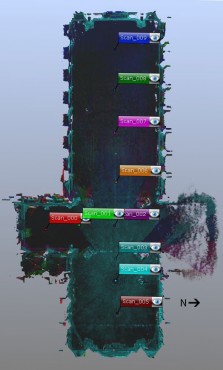Netley Abbey
In January of this year myself and Dan Joyce completed a series of recording techniques at Netley Abbey, including time of flight and phase scanning, photogrammetry and Reflectance Transformation Imaging. The work was organised by Dan in collaboration with English Heritage for his individually negotiated topic for his masters degree.
The main aim of the investigation was to teach Dan how to correctly capture difficult architectural remains using these techniques and the following are examples of the work completed. Furthermore, our investigation followed on from a past Southampton University project and has now led to a full geophysical survey, building survey and 3D models of the standing ruined architecture.
Part of the remains of the abbey were first recorded using a Leica Scanstation C10 and were then captured further using a Faro Focus 3D. The C10 was used as a means to record high resolution data of specific parts of the abbey at mm accuracy that were too high to be recorded at the same resolution as the Faro. Instead the Faro was used to capture an overall model of the building and below are the scan positions that were used followed by a short animation of the laser scan model.
Photogrammetry was used on a number of different areas within the building to highlight the differences between small object and large object data collection techniques. These were then used within Dan’s work as a way to compare the different recording techniques through the final representations available. Below are two renders of the the East window of the abbey and a a rendered image of a column



Further to these two methods, RTI was also used on a series of graffiti markings to make the writing more legible and also included within the research was the capturing of a series of gigapixel images, the first showing an overview of the building, the second highlighting the East window and the third showing the West window

